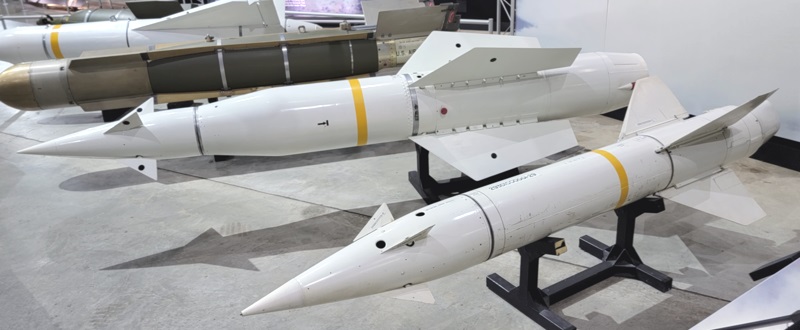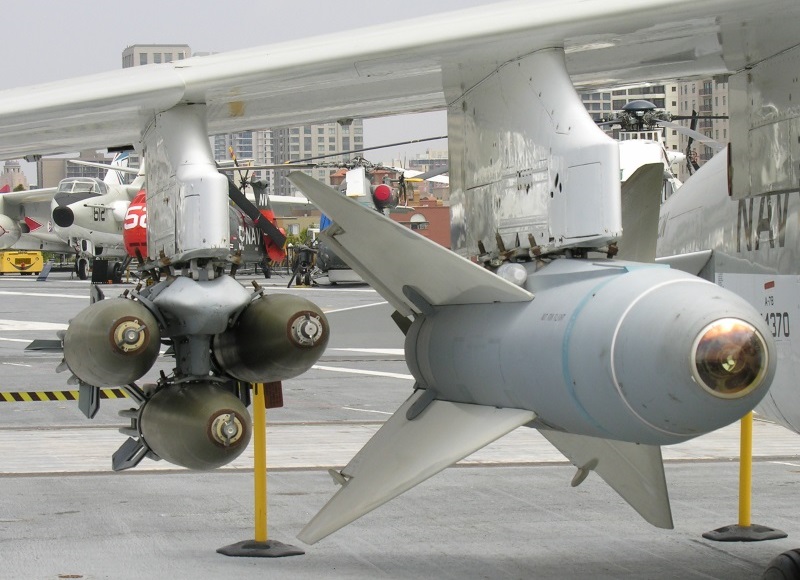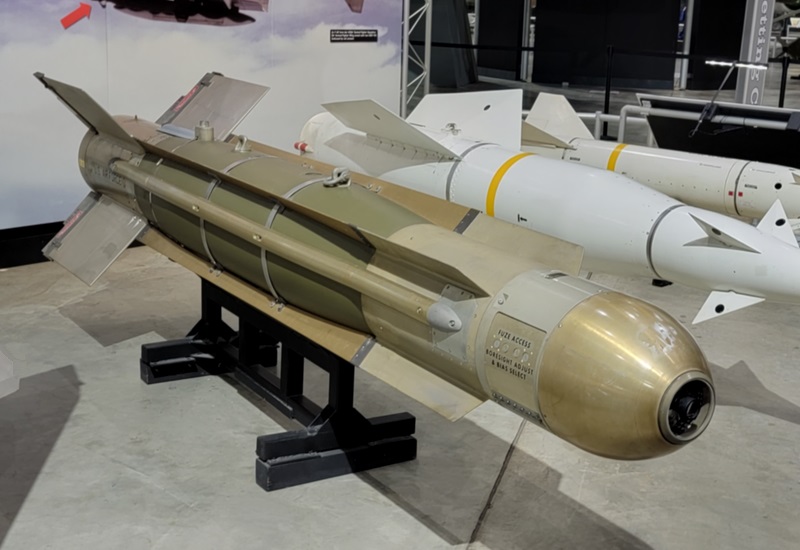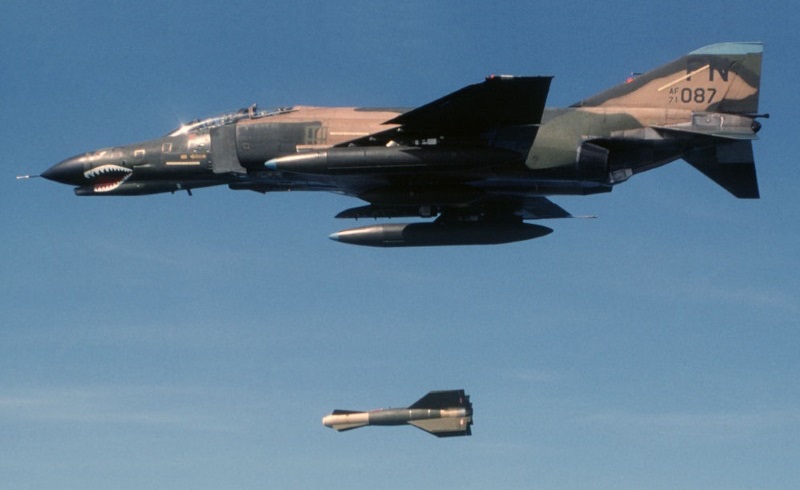
* US work with guided munitions after World War II through the 1950s didn't amount to much. It was the Vietnam War that energized American development of smart munitions, producing early electro-optic guided bombs and laser-guided bombs. From the 1990s, the US followed up such smart munitions technologies with weapons using the Global Positioning System (GPS) navigation satellite constellation for precision guidance.
* The US military tinkered with guided munitions during World War II, most notably with the AZON, RAZON, and TARZON radio-guided bombs, but they were not widely used and left something to be desired. During the Korean War, air strikes were performed with unguided munitions; the US Navy decided they left something to be desired as well, and in 1953 began development of a guided air-to-surface missile (ASM). A contract was awarded to Martin's Orlando Division in 1954, and the resulting weapon, the "ASM-N-7 Bullpup", was fielded by the Navy in 1959.
In 1960, production moved to an improved variant, the "ASM-N-7A", which replaced the original Aerojet solid-fuel motor of the ASM-N-7 with a more powerful Thiokol liquid-fuel motor with prepacked storable fuels. The ASM-N-7A was redesignated "AGM-12B" in 1962, and was generally known as "Bullpup-A".
The AGM-12B was a cheap and relatively crude weapon, not really very much advanced from the radio-guided munitions of WWII, It was a sleek rocket, with small pneumatically-operated cruciform control fins on the nose and larger fixed cruciform fins on the tail. The AGM-12B was roll-stabilized, optically guided, and controlled over a radio link, much as the German weapons had been. It had two flares in the tail to allow the operator to track it while using a joystick to keep it lined up through the aircraft's gunsight. The radio control system, which was based on an AN/AWW-73 or AN/AWW-77 underwing pod, had multiple channels to allow several aircraft to launch Bullpups simultaneously.
___________________________________________________________________
AGM-12B BULLPUP-A:
___________________________________________________________________
wingspan:
0.94 meters (3 feet 1 inch)
length:
3.2 meters (10 feet 6 inches)
total weight:
259 kilograms (571 pounds)
warhead weight:
113 kilograms (250 pounds)
speed:
Mach 1.8
range at altitude:
11 kilometers (7 MI / 6 NMI)
___________________________________________________________________
Although the US Air Force used some stock Bullpup-As as the "GAM-83", they were obtained strictly as an interim solution until the service could get an enhanced variant of the Bullpup-A, originally designated "GAM-83A" but confusingly redesignated "AGM-12B" in 1962 even though it wasn't the same as the Navy AGM-12B. The Air Force AGM-12B featured an improved guidance system that relaxed the need for the pilot to keep the target lined up in the gunsight, allowing attacks on targets off the launch aircraft's line of flight.
Eventually, the USAF also sponsored development of another Bullpup-A variant, originally known as the "GAM-83B", but redesignated the "AGM-12D". This variant looked much like the AGM-12B, but had a slightly larger diameter that allowed it to carry either a conventional high-explosive or a tactical nuclear warhead.
Tens of thousands of Bullpup-As were built, mostly by W.L. Maxson Electronics as a subcontractor to Martin Marietta, with another 8,000 built under license by a European group headed by Kongsberg of Norway. The Bullpup-A was carried by US Navy aircraft such as the Douglas A-4 Skyhawk and the Lockheed P-3 Orion, and US Air Force aircraft such as the North American F-100 Super Saber and Lockheed F-104 Starfighter. The Bullpup-A was also adopted by the British Royal Navy, as well as Denmark, Norway, and Turkey.

* Even as the Bullpup-A was being fielded, Martin was working on a larger version of the weapon for the Navy. The bigger Bullpup was originally designated "ASM-N-7B" but later changed to "AGM-12C", and generally known as "Bullpup-B". Bullpup-B used the same guidance and control scheme, but had a chunkier body and big rear fins.
___________________________________________________________________
AGM-12C BULLPUP-B:
___________________________________________________________________
wingspan:
1.22 meters (4 feet)
length:
4.14 meters (13 feet 7 inches)
diameter:
45.7 centimeters (18 inches)
total weight:
810 kilograms (1,785 pounds)
warhead weight:
450 kilograms (1,000 pounds)
speed:
supersonic
range at altitude:
16 kilometers (10 MI / 9 NMI)
___________________________________________________________________
The Bullpup-B was introduced into service in 1963, and 4,600 were built. The USAF ordered a variant of the Bullpup-B designated "AGM-12E", with an antipersonnel warhead for attacking missile sites, but only about 840 were manufactured, out of a total of about 30,000 Bullpups of all types produced to end of production in 1969.
Both the Bullpup-A and Bullpup-B were used by American forces during the Vietnam War, with disappointing results. Its guidance system left the launch aircraft exposed until weapon impact, and the Bullpup's warhead was too small to seriously damage solid targets like bridges. Some sources also hint at reliability problems. The Bullpup was phased out of service in the US Navy and USAF beginning in the 1970s, with the last of them out of service in the early 1980s.
Martin also built a training version of the Bullpup, essentially a modified HVAR rocket -- a 12.7-centimeter (5-inch) unguided rocket of WWII vintage -- with a Bullpup control system, but it was eventually replaced by old Bullpup-As fitted with inert warheads.
Late in the Bullpup's life, there were attempts to build enhanced follow-on versions:
It is a little odd that there was no scheme to retrofit the large numbers of old Bullpups to SAL-guided Bulldog spec and turn them into much more useful weapons. Apparently such a measure was either not technically reasonable, or not thought to be cost-effective even if it was.
* Through much of the war in Vietnam, the US relied on unguided bombs and rockets that had been developed after WWII. During that conflict, the bombs carried by American aircraft were typically "fat" bombs, like stubby sausages with box fins. The shift towards faster aircraft led to more streamlined "slick" bombs with cruciform fins in the 1950s, beginning with the:
The weight could vary somewhat, depending on fuzing and the use of "retarders" to slow the bomb after dropping at low level, lest it blow up the drop aircraft. These bombs led to the "Mark 80" series of "Low Drag General Purpose (LDGP)" bombs. The Mark 80 "slick" bombs were spindle-shaped munitions, filled with about 50% explosive by weight. Four variants were introduced:
Boxing categories are used here as informal labels for the weight class. All six types of bombs were used in Vietnam and afterward, with the Mark 80 series persisting to the present. Two types of unguided rockets were used in Vietnam as well:
Both types of rockets had folding fins and could be fitted with a variety of screw-on warheads -- high explosive, fragmentation, armor-piercing, smoke, and so on -- which apparently is where the "Hydra-70" name came from. Both were fired from multi-tube launchers, with 7- and 19-tube launchers being typical for Hydra-70, while Zunis usually were fired from four-tube launchers. In any case, these unguided munitions would become the basis for new-generation smart munitions.
BACK_TO_TOP* One of the biggest problems with the radio-guided glide bombs of World War II was the crudity of electronic technology of the era. TV and infrared sensor technology were in their infancy, hampered by poor performance and lack of reliability. By the 1960s they had matured, with the new solid-state electronic technology allowing weapon systems to be much more reliable and compact.
The US air war over Southeast Asia started in earnest in 1964, quickly demonstrating that existing weapon systems left something to be desired. Pilots performing strikes on North Vietnam's bridges -- major targets in the attempt to cut the flow of weapons and supplies to Vietcong insurgents in South Vietnam -- found them to be very difficult targets, both hard to hit and hard to damage when they were hit. The Bullpup turned out to be almost useless; it was too hard to fly straight, and not powerful enough to do much damage.
Better solutions were needed. Development of improved guided bombs during the 1960s was conducted along two paths, mentioned earlier:
US Navy work on an EOGB led to the Martin Marietta "Walleye". The Navy had begun investigation on the weapon in 1963, with a production contract awarded to Martin's division in Orlando, Florida, in early 1966. The weapon was designated the "AGM-62", where "AGM" meant "Air-to-Ground Missile" -- though that was misleading, a glide bomb wasn't really a "missile" since it wasn't powered.
The "Walleye I" had four cropped delta wings arranged in a cruciform pattern, with control fins at the trailing edge; a vidicon-tube TV camera in the nose; a spinner in the tail to drive a hydraulic pump and electrical generator; and a 375-kilogram (825-pound) warhead. The Walleye I was 3.44 meters (11 feet 4 inches) long, with a diameter of 32 centimeters (12.5 inches); a wingspan of 1.16 meters (3 feet 10 inches); and a weight of 500 kilograms (1,100 pounds).
The Walleye I went into combat in early 1967, being carried by Navy Douglas A-4 Skyhawk light attack aircraft in early 1967. Results were impressive: in the first strike, a Skyhawk pilot sent a bomb directly into a window of a barracks building. Of 68 Walleyes dropped over a period of seven months, 65 were precisely on-target.

In operation, the image provided by the Walleye's seeker was displayed on a TV screen in the drop aircraft. The operator locked the crosshairs on the display onto a high-contrast scene element, such as a window or a door; set the warhead fuzing option as desired; and dropped the weapon. The Walleye would then guide itself into the target, zeroing in on the target contrast pattern.
The seeker used an analog pattern-matching scheme, with brightness along the horizontal and vertical axes of the target image converted into dual analog electrical waveforms. The seeker control electronics would then detect the transitions in the waveforms corresponding to abrupt changes in scene brightness, and use them as "goalposts" to send the missile into its target. It was a "fire-&-forget" weapon, able to perform a "terminal attack" on its own.
The seeker needed to have a stable high-contrast pattern to work properly; it could break lock if the day was gray and hazy, or there were shifting clouds or sources of transient sun glare. In such cases, "fire-&-forget" actually turned out to mean that the weapon was fired and then forgot where it was going. However, when the weapon worked, which was at least more often than not, it worked very well, with accuracies of a few meters.
The Navy was enthusiastic enough about the Walleye to also configure A-6 Intruder and A-7 Corsair II strike aircraft to carry the weapon, and develop a 900-kilogram (2,000-pound) "Walleye II", nicknamed "Fat Albert". The Walleye II was built by Hughes under subcontract to Martin Marietta. It looked like a scaled-up Walleye I, being 4.04 meters (13 feet 3 inches) long, with a diameter of 46 centimeters (18 inches), and a wingspan of 1.3 meters (4 feet 3 inches). The Walleye II went into service in 1974.
The Walleye II was followed in 1975 by the "Extended Range / Data Link (ERDL)" Walleye, which featured bigger wings for longer glide range and a more sophisticated guidance and control system. Most of the Walleye I and II weapons were upgraded to "Walleye I ERDL" and "Walleye II ERDL" configuration. The ERDL system allowed an operator to monitor the Walleye's seeker over an "AN/AWW-9" (later "AN/AWW-13") radio datalink pod, and change the target lock after launch if necessary.
The controlling aircraft wasn't necessarily the same as the launch aircraft; it was often better to have one aircraft stand off from the target and guide the bombs, while others released them and got out of the target area. Such "buddy targeting" not only enhanced effectiveness and increased crew safety, but also meant that not all the strike aircraft needed to be fitted with the datalink pod. An updated "digital phase-shift keying (DPSK)" guidance system with a more reliable communications channel was retrofitted in the 1980s, resulting in the "Walleye I ERDL DPSK" and "Walleye II ERDL DPSK".
The Walleye was also obtained in small quantities by the USAF, as well as the Israeli Air Force. The Israelis used Walleye IIs in the Yom Kippur War in 1973 with mixed results; to then come up with a modified version, the "Tadmit", with an improved seeker and a booster rocket, that was used successfully in the 1982 war in southern Lebanon. The US Navy used Walleyes to good effect in the First Gulf War, dropping 124 of them on Iraqi targets.
The weapon was finally withdrawn from service in 1995, at the time the A-7 was retired, no other Navy aircraft being qualified for the weapon. About 5,000 Walleyes of all types were produced, including inert training rounds were built, and even a nuclear-armed Walleye, the "Guided Weapon Mark 6". It seems the nuclear Walleye never reached operational status.
BACK_TO_TOP* In 1967 the US Air Force, working with Rockwell International, began development of their own EOGB. The first weapon in this series materialized in combat over Southeast Asia in 1969 as the "GBU-8/B HOBOS (Glide Bomb Unit 8, Homing Bomb System)". Unlike Walleye, HOBOS was a modular system, the GBU-8 being a Mark 84 heavyweight slick bomb with:
A HOBOS weapon based on the Mark 84 slick bomb was 3.78 meters (12 feet 5 inches) long, had a span of 1.12 meters (3 feet 8 inches), and weighed 1.016 tonnes (2,240 pounds). There was also a "GBU-9/B", with nose and tail kit and attached to the M118 1,360-kilogram (3,000-pound) bomb, though again it seems to have got relatively little use.
A 900-kilogram (2,000-pound) "penetrator" bomb, the "BLU-109/B", was added to the set in the 1980s -- "BLU" meant "Bomb Live Unit", by the way. It featured a thick, hard casing, allowing it to penetrate reinforced concrete bunkers and such. The fuze was fitted to the tail -- a better location than the nose for a penetrating weapon -- and set for delayed action, so the bomb wouldn't detonate until after it had broken into a bunker.
The EO seeker head was based on either TV or imaging infrared technology, though it appears there were a number of experiments with other options. Like the Walleye, the seeker in principle had a fire-&-forget capability, in which the operator could lock it onto a target, with the bomb then directing itself into the target. Also like the Walleye, occasionally "fire-&-forget" meant the weapon would forget where it was going -- but again, when it worked it, worked well.

* After the end of the war, the Air Force and Rockwell continued development of the weapon through the 1970s, eventually coming up with the better "GBU-15/B EOGB", originally the "AGM-112" -- the TV-guided "GBU-15(V)1/B" becoming operational in 1983, and the infrared-guided "GBU-15(V)2/B" following two years later. The weapon was fielded by the USAF and the Israeli Air Force, with the Israelis using it effectively in Lebanon in 1982.
The GBU-15/B was actually a family of weapons based on a kit of standard components, known as the "modular guided glide bomb" system. The Air Force also worked with Hughes to build a glide bomb with a pair of "switchblade" pop-open wings for extended glide range, but this "GBU-20/B Planar Wing Weapon (PWW)" never reached production.
The GBU-15/B was conceptually similar to HOBOS, with tail and nose sections strapped to a heavyweight Mark 84 bomb. The kit could be attached to some other munitions, and was also evaluated with a cluster munition canister, though that option never went into service. The standard GBU-15/B had a length of 3.5 meters (12 feet 10 inches), a wingspan of 1.49 meters (4 feet 11 inches), and a weight of 1.125 tonnes (2,500 pounds).
The EO seeker permitted fire-&-forget operation or, unlike the GBU-8/B, command guidance through an AN/AXQ-14 or the later AN/ZSW-1 datalink. Datalink guidance allowed the bomb to be released from above an overcast layer, with the bomb falling under command guidance until it penetrated the cloud layer, where it then locked on to the target.

The GBU-15/B had a distinctively different appearance from HOBOS, however, with triangular nose fins on the seeker section and large truncated-delta fins on the tail section, both sets of fins being arranged in a cruciform pattern. As a result, the GBU-15/B was sometimes referred to as the "cruciform wing weapon (CWW)". The bigger fins gave the GBU-15/B a longer glide distance than HOBOS.
The GBU-15/B was carried by the F-15E Strike Eagle and, while it was still in service, the F-111 Aardvark. The F-111 made very effective use of the GBU-15/B during the First Gulf War, dropping 71 to seal off oil manifolds wrecked by the Iraqis to spew out oil, and other targets.
GBU-15/B kits were developed that featured smaller "short chord" wings; these kits could be used on the BLU-109/B 900-kilogram (2,000-pound) penetrator warhead -- which, for whatever reasons, could not be fitted with the long-chord wings. This gave a "Chinese menu" of possible weapon configurations:
In 1999 and 2000, many GBU-15 munitions were updated with a midcourse guidance system, based on the US military's Global Positioning System (GPS), which is based on a constellation of satellites that broadcast signals to allow a GPS receiver on Earth to pinpoint its location to within a few meters. Since GPS broadcast power is low, GPS is easily jammed, and so munitions weapons with GPS also need a backup inertial navigation system (INS) -- with lower accuracy -- to keep them on track if GPS is jammed.
In practice, with a long-range weapon, jamming in the target area would only disrupt GPS as the weapon approached the target, and the INS would be perfectly adequate to perform a precision attack -- all the more so if the INS were calibrated in software during its time in flight while GPS wasn't jammed and could be used as a reference. GPS-INS provided a highly-reliable fire-&-forget guidance system In any case, "EGBU-15" munitions with GPS-INS guidance were introduced to combat in the First Gulf War. Apparently, all the GBU-15 family munitions have now been retired.
* There is of course a fine line between a glide bomb and an air-to-surface missile -- with this line being crossed by the "AGM-130" ASM, a direct derivative of the GBU-15 EOGB.
It consisted of a heavyweight Mark 84 GP or BLU-109/B penetrating bomb body with a short-chord wing kit and a solid-rocket booster to give it considerably extended range, roughly 64 kilometers (40 miles). A terrain-following guidance system based on a radar altimeter was used for midcourse navigation to the target. That would appear to be a simple enough concept, but the weapon's development was apparently troublesome. Although development began in 1984, the AGM-130 didn't become operational until after the First Gulf War.
Production versions of the AGM-130 featured a GPS-INS subsystem backing up the terrain-following navigation. The optical seeker was updated to include a 256-by-256 pixel cadmium-telluride infrared imaging array, along with a CCD-based television imager.
The AGM-130 saw its first use in combat in the air strikes conducted by the US military against Iraqi air-defense sites that began in December 1997. Ten were fired, but in late January 1998 one of the AGM-130s missed its intended military target and hit a residential area, suggesting that not all the bugs had been worked out. They were employed again in the Afghanistan war in 2001, being used to perform precision strikes into the entrances of caves used as hideouts by al-Qaeda terrorists. There was talk of improvements to the AGM-130, but only about 500 were built, and there seems to be little activity in the weapon today. It may linger in inactive storage.

* Boeing, which eventually became the owner of the GBU weapons and the AGM-130 through the US defense industry consolidation binge of the 1990s, worked with the US Air Force on a turbojet-powered variant of the AGM-130, known informally as the "AGM-130TJ", to provide a longer-range and lighter weapon that could be carried on F-16 fighters as well as F-15Es.
The AGM-130TJ was smaller than the original AGM-130, with weight cut from 1,360 kilograms (3,000 pounds) to 1,072 kilograms (2,365 pounds), and was powered by a French-designed Microturbo small turbojet engine. Range was over 120 kilometers (80 miles), twice that of the original AGM-130. The AGM-130TJ followed studies performed some years earlier on a turbojet-powered derivative of the AGM-130 for the British CASOM (Conventionally Armed Stand-Off Munition) competition, as well as more recent experiments with a lighter version of the AGM-130 powered by a solid-rocket motor. A USAF F-15 performed the first test launch of the AGM-130TJ in September 1998, but the USAF decided not to pursue development of the weapon.
BACK_TO_TOP